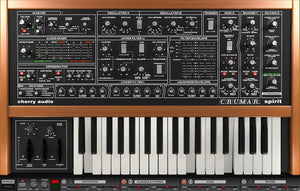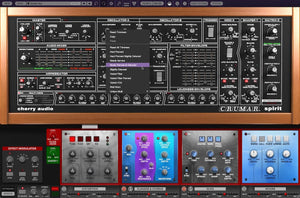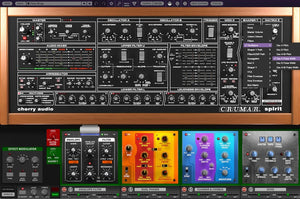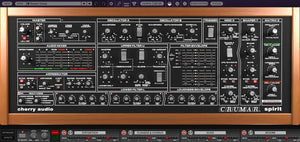Your Cart is Empty




Cherry Audio Crumar Spirit
The Mystical Italian Classic Reimagined
$59.00
Rated 5.0 out of 5 stars
1 Review
Description
Crumar Spirit by Cherry Audio is a meticulously crafted virtual recreation that captures the unique and captivating features of the exceptional analog monosynth from 1983, originally designed by some of the most legendary figures in the synth industry. In collaboration with Crumar, we have reopened a time capsule to revive this Italian cult classic and thoughtfully elevated it with Cherry Audio's signature style.
Spirit is a gateway to sonic experimentation, whether you are after wild, unpredictable timbres or warm, analog tones. It is not a polite instrument. Nor is it clean, safe, or obvious. However, twist a few knobs and it will reward you with some of the most colorful sounds you have ever heard from a virtual analog software synthesizer.
Crumar Spirit includes over 430 sensational presets in 12 categories
Producers will find immediate inspiration in Spirit's extensive preset library, created by a talented sound design team led by veteran sound designer James Terris. And don't miss the Spectres for Spirt Preset Pack (sold separately), featuring an additional 100 additional presets by James Dyson.
A "Little Synth" Designed by Legends
Crumar S.P.A., based in Castelfidardo, Italy, was a notable player in the 1970s musical instrument industry, specializing in home organs, digital pianos, and multi-sound keyboards, and with a significant focus on the U.S. market. Sante Crucianelli, the son of the owner, became the driving force behind Crumar's design and strategies. Crumar became known for its open lab culture, frequently allowing competitors to test instruments, a rare practice for the time. Another key figure during this period was Luciano Jura, a designer, musician, and programmer. Luciano became crucial as Crumar's point of contact with synth pioneer Bob Moog, which led to a collaboration that resulted in the creation of Crumar's Spirit synthesizer.
Although many details have been lost due to the passing of key figures and the closure of Crumar, the development of the Spirit synthesizer in the U.S. is well documented. Key contributors to the project, codenamed "Little Synth," included Moog engineer Jim Scott, Moog clinician and electronic music historian Tom Rhea, and Bob Moog himself. The project likely began around 1980 or 1981, and incorporated elements from earlier projects by Scott and Moog. Rhea played an essential role in defining the Spirit's key features, such as the keyboard scanning setup, panel layout, functional architecture, and technical documentation. The Crumar Spirit went into production and was released in late 1983.
More than Meets the Eye
The Spirit synthesizer, despite its surface resemblance to other analog monosynths of the period, featured several unique attributes that set it apart. Its architecture included integrated circuits also found in highly regarded synthesizers like the Rhodes Chroma, Memorymoog, various Oberheims and Prophets, PPG Waves, the Super Jupiter, and the Ensoniq ESQ1 and SQ80. The Spirit was equipped with two CEM3340 oscillators, CEM3350 Dual VCFs, and six CEM3360 Dual VCAs.
Spirit boasted two VCOs, which could be synced together. Oscillator B offered independent octave range settings relative to Oscillator A, as well as the ability to be decoupled from the keyboard's pitch CV for drone or extended range possibilities. Oscillator B could be used as a modulation source for Oscillator A.
The Spirit routed the oscillators through two distinct signal paths, one with the VCFs and VCA (referred to as the upper Filter/ADSR path) and another with a mixer that includes the ring modulator and noise generator controlled by the "Shaper-Y" LFO/EG. The Spirit's filter section featured both an upper low-pass filter and a lower filter with high-pass, band-pass, and a distinct "Overdrive" mode for adding a distinct saturated quality to the sound. It provided switchable filter slopes of either 12dB or 24dB, and an independent filter envelope enabled precise control of the filter's dynamics, separate from the ADSR envelope. Dynamic keyboard tracking is available for both filters, with a switch for a fixed formant option for the lower filter.
Its extensive modulation options were one of Spirit's standout features, featuring two LFOs, Mod-X and Shaper-Y, which provided a wide range of modulation routing possibilities. Each LFO has a dedicated mod wheel for real-time control of modulation depth, with Mod-X sources including triangle wave, square wave, Sample & Hold (S&H), Shaper Y, red noise, and Oscillator B. Shaper-Y could also work as a loopable two-stage envelope or function as a free-running LFO.
Furthermore, the Spirit included a unique arpeggiator with three patterns, including an elaborate "Leap" mode that allowed for intricate multi-octave sequences. The ring modulator added harmonic richness and metallic tones, while the external audio input feature enabled the processing of outside signals. The Spirit had two portamento modes: "On," which operated like most synths, and "Auto," which activated only when the first key was held down while playing the second.
The Crumar Spirit was a complex instrument known for its powerful features and unique design, making it a valuable tool for musicians seeking deep synthesis capabilities. However, it faced commercial difficulties, arriving on the market after Yamaha's DX7 and during a period when musical trends were shifting towards digital and full polyphony. Estimates suggest that as few as 100 or less Spirit synthesizers were manufactured. Additionally, a crisis in Italy's instrument industry further complicated its situation, and Crumar ceased operations in 1986.
Cherry Audio's reenvisioning of the Spirit synthesizer includes all the innovations and deep sound capabilities of the original hardware while enhancing it with modern design elements tailored for today’s musicians and sound designers. We have increased its polyphony and added more voice modes, along with expanding its already extensive modulation capabilities with a new "Matrix Z" control, a mod matrix with four independent pathways.
Spirit's unique arpeggiator has been replicated and enhanced with swing, chance, and feel to add degrees of randomness and a human touch to patterns. Additionally, we have integrated dual chains of studio-grade effects, made the synthesizer more expressive with velocity and aftertouch (including polyphonic aftertouch), and provided 400 presets created by six professional sound designers. All of this is presented in an easy-to-navigate interface, making this once-esoteric synth feel like an old friend.
Tech Specs
Crumar Spirit by Cherry Audio is available in AU, VST, VST3, AAX, and standalone formats.
macOS Requirements: macOS Requirements: macOS 10.13 or above. 64-bit required. Intel or Apple Silicon processor. 3.4 GHz Quad-Core or Apple Silicon CPU with 8GB of RAM is recommended. Hard disk space: 96 MB.
Windows Requirements: Windows 7 or above (including Windows 11), 64-bit required. 3.4 GHz Quad-Core computer with 8GB of RAM recommended. Hard disk space: 96 MB.
NOTE: Internet connection required for product activation







